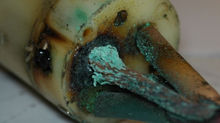INTERNAL / EXTERNAL CORROSION
Leaky steel tubing can be the beginning of the end for efficient heat transfer. Although many stainless steel coils may fail for a variety of reasons, mechanical failure and corrosion are the culprits in the majority of cases. When steel coils corrode, unwanted precipitation and contaminants may foul the air stream or exhaust gases. Steam can leak from a badly corroded coil simply blowing precious energy off into the atmosphere.
External corrosion is when one or more contaminants in the airstream causes deterioration to the heat exchangers tubing. Dirt buildup intensifies corrosive action by trapping contaminants in secreted pockets. Also this contamination is accelerated when dirt becomes strong airborne mist. Factors such as inappropriate fin pitch, fabricating techniques and material selection may also fuel external corrosion.

Internal corrosion retention of contaminated moisture or inadequate venting of noncondensable gas are major causations. CO2 gas dissolved in condensate that has cooled below steam temperature, it forms highly corrosive carbonic acid. Likewise, oxygen left to stagnate in the system can foster corrosive actions by pitting iron and stainless steel surfaces. Connected pipes/tubes in headers of dissimilar materials may spawn galvanic action. The internal stresses caused to improper welding may also hasten corrosion damage.

Tube and coil design is one of the best defenses against external corrosion. We offer a wide selection of fin and regular tube cooling coils. As a defense against non-environmental factors, Lizheng Stainless Steel Tube & Coil Corp. fabricates coils in a full range of metals and alloys you might need. You may also specify special designs/drawings to be manufactured to your liking.















